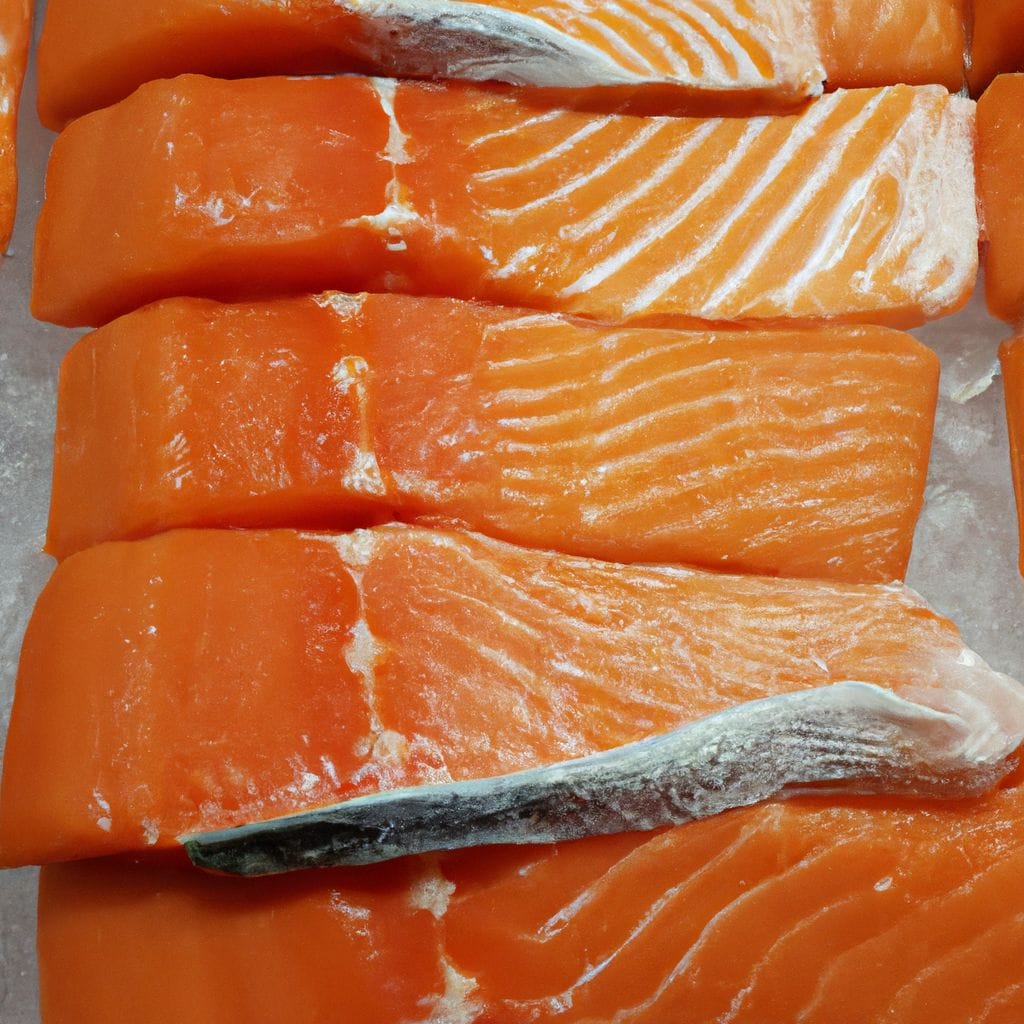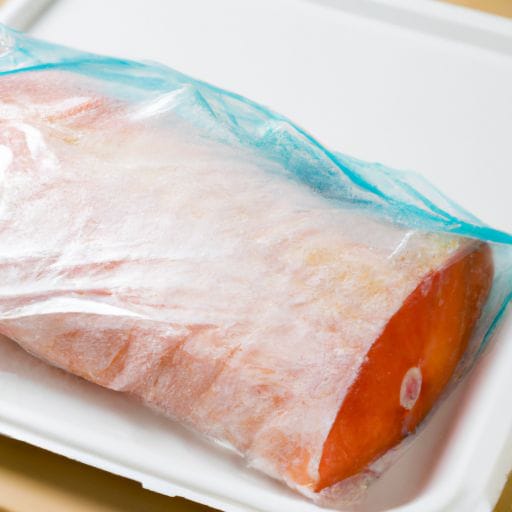Can You Freeze Salmon Fillets? The answer is yes! Freezing salmon fillets is a great way to preserve the freshness and flavor of the fish. It is also a convenient way to store salmon for later use. Freezing salmon fillets is a simple process that requires minimal preparation and can be done in a matter of minutes. In this article, we will discuss the best methods for freezing salmon fillets, as well as tips for thawing and cooking them.
How to Properly Freeze Salmon Fillets for Maximum Freshness
Contents
- 1 How to Properly Freeze Salmon Fillets for Maximum Freshness
- 2 The Benefits of Freezing Salmon Fillets for Long-Term Storage
- 3 Tips for Preparing Salmon Fillets for Freezing
- 4
- 5 The Best Way to Thaw Frozen Salmon Fillets
- 6 How to Tell if Frozen Salmon Fillets Have Gone Bad
- 7 The Different Types of Salmon Fillets and How to Freeze Them
- 8 The Best Way to Reheat Frozen Salmon Fillets
- 9 Creative Recipes for Using Frozen Salmon Fillets
- 10 FAQs:
- 11 1. Can you freeze salmon fillets?
- 12 2. How long can you keep salmon fillets in the freezer?
- 13 3. How should you prepare salmon fillets for freezing?
- 14 4. How should you thaw frozen salmon fillets?
- 15 5. Can you refreeze thawed salmon fillets?
- 16 6. How long can you keep thawed salmon fillets in the refrigerator?
- 17 7. Can you cook frozen salmon fillets?
- 18 8. How should you cook frozen salmon fillets?
- 19 Conclusion
Freezing salmon fillets is a great way to preserve their freshness and flavor for up to six months. Here are some tips to help you freeze your salmon fillets for maximum freshness:
1. Start with fresh, high-quality salmon fillets. Make sure they are free of any visible signs of spoilage.
2. Rinse the fillets in cold water and pat them dry with paper towels.
3. Place the fillets on a baking sheet lined with parchment paper.
4. Place the baking sheet in the freezer for about two hours, or until the fillets are frozen solid.
5. Once the fillets are frozen, transfer them to a freezer-safe container or bag.
6. Label the container or bag with the date and type of fish.
7. Place the container or bag in the freezer.
Following these steps will help you freeze your salmon fillets for maximum freshness. Enjoy your delicious, fresh salmon fillets for up to six months!
The Benefits of Freezing Salmon Fillets for Long-Term Storage
Freezing salmon fillets is an excellent way to store them for long-term use. Not only does freezing help to preserve the flavor and texture of the fish, but it also helps to extend its shelf life. Here are some of the benefits of freezing salmon fillets for long-term storage:
1. Convenience: Freezing salmon fillets is a convenient way to store them for later use. You can freeze the fillets in individual portions, so you can thaw out only what you need for a meal. This eliminates the need to buy large amounts of fresh salmon and ensures that you always have some on hand.
2. Cost Savings: Freezing salmon fillets can save you money in the long run. By freezing the fillets, you can buy them in bulk when they are on sale and store them for later use. This eliminates the need to buy fresh salmon every time you want to cook it.
3. Quality: Freezing salmon fillets helps to preserve the quality of the fish. The cold temperatures help to keep the fish from spoiling and retain its flavor and texture. This ensures that you get the best quality salmon every time you cook it.
Freezing salmon fillets is an easy and cost-effective way to store them for long-term use. Not only does it help to preserve the quality of the fish, but it also helps to save you money in the long run. So, if you’re looking for a way to store your salmon for later use, consider freezing it!
Tips for Preparing Salmon Fillets for Freezing
1. Start with fresh, high-quality salmon fillets. Look for fillets that are firm and have a bright, even color.
2. Rinse the fillets in cold water and pat them dry with paper towels.
3. Place the fillets on a baking sheet lined with parchment paper.
4. Place the baking sheet in the freezer for about an hour, or until the fillets are frozen solid.
5. Once the fillets are frozen, transfer them to a freezer-safe container or bag.
6. Label the container or bag with the date and type of fish.
7. Place the container or bag in the freezer.
8. When you’re ready to cook the salmon, thaw it in the refrigerator overnight.
9. Enjoy your delicious, frozen salmon fillets!
The Best Way to Thaw Frozen Salmon Fillets
Thawing frozen salmon fillets is a breeze! Here’s the best way to do it:
1. Place the frozen fillets in a shallow dish and cover with cold water.
2. Change the water every 30 minutes until the fillets are thawed.
3. Once thawed, pat the fillets dry with a paper towel and they’re ready to cook!
This method is quick and easy, and it ensures that your salmon fillets are thawed evenly and safely. Plus, it’s a great way to get dinner on the table in no time!
How to Tell if Frozen Salmon Fillets Have Gone Bad
If you’re wondering if your frozen salmon fillets have gone bad, don’t worry! It’s easy to tell if your salmon has gone bad. Here are a few tips to help you out:
1. Check the color. Fresh salmon should have a bright pinkish-orange hue. If the color has faded or turned gray, it’s likely gone bad.
2. Smell it. Fresh salmon should have a mild, fishy smell. If it smells sour or off, it’s likely gone bad.
3. Feel it. Fresh salmon should be firm and moist. If it feels slimy or dry, it’s likely gone bad.
4. Check the expiration date. If the salmon is past its expiration date, it’s likely gone bad.
If you follow these tips, you’ll be able to tell if your frozen salmon fillets have gone bad. Enjoy your salmon!
The Different Types of Salmon Fillets and How to Freeze Them
Salmon is a delicious and nutritious fish that can be enjoyed in a variety of ways. Whether you’re grilling, baking, or pan-frying, there are many different types of salmon fillets to choose from. Here’s a quick guide to the different types of salmon fillets and how to freeze them.
The most common type of salmon fillet is the Atlantic salmon. This type of salmon is usually farmed and has a mild flavor. It’s a great choice for grilling, baking, or pan-frying. To freeze Atlantic salmon, wrap it tightly in plastic wrap and place it in a freezer-safe container.
Another popular type of salmon is the sockeye salmon. This type of salmon is wild-caught and has a richer flavor than Atlantic salmon. It’s perfect for grilling or baking. To freeze sockeye salmon, wrap it tightly in plastic wrap and place it in a freezer-safe container.
The third type of salmon is the Chinook salmon. This type of salmon is also wild-caught and has a rich, buttery flavor. It’s great for grilling, baking, or pan-frying. To freeze Chinook salmon, wrap it tightly in plastic wrap and place it in a freezer-safe container.
Finally, there’s the pink salmon. This type of salmon is usually farmed and has a mild flavor. It’s perfect for grilling, baking, or pan-frying. To freeze pink salmon, wrap it tightly in plastic wrap and place it in a freezer-safe container.
No matter which type of salmon fillet you choose, freezing it is a great way to preserve its flavor and texture. With these tips, you’ll be able to enjoy delicious salmon dishes all year round!
The Best Way to Reheat Frozen Salmon Fillets
Reheating frozen salmon fillets is a great way to enjoy a delicious meal without having to start from scratch. Here’s the best way to do it:
First, preheat your oven to 350 degrees Fahrenheit. Then, place the frozen salmon fillets on a baking sheet lined with parchment paper. Sprinkle the fillets with a bit of salt and pepper, and then drizzle them with a bit of olive oil.
Next, bake the salmon fillets for about 15 minutes. You’ll know they’re done when they’re flaky and cooked through.
Finally, enjoy your delicious, freshly-reheated salmon fillets! They’ll be just as tasty as if you had cooked them from fresh.
Reheating frozen salmon fillets is a quick and easy way to enjoy a delicious meal. With just a few simple steps, you can have a delicious meal in no time!
Creative Recipes for Using Frozen Salmon Fillets
1. Salmon Burgers: Transform frozen salmon fillets into delicious burgers! Simply thaw the fillets, then mix with a few tablespoons of mayonnaise, a tablespoon of Dijon mustard, a tablespoon of lemon juice, and a tablespoon of chopped fresh dill. Form the mixture into patties and cook in a skillet over medium heat for about 4 minutes per side. Serve on a toasted bun with your favorite toppings.
2. Salmon Cakes: Make a tasty dinner with frozen salmon fillets! Thaw the fillets, then mix with a few tablespoons of mayonnaise, a tablespoon of Dijon mustard, a tablespoon of lemon juice, and a tablespoon of chopped fresh dill. Form the mixture into patties and cook in a skillet over medium heat for about 4 minutes per side. Serve with a side of roasted vegetables or a salad.
3. Salmon Tacos: Turn frozen salmon fillets into a delicious taco dinner! Thaw the fillets, then mix with a few tablespoons of mayonnaise, a tablespoon of Dijon mustard, a tablespoon of lemon juice, and a tablespoon of chopped fresh dill. Form the mixture into patties and cook in a skillet over medium heat for about 4 minutes per side. Serve in warm tortillas with your favorite taco toppings.
4. Salmon Fritters: Make a tasty snack with frozen salmon fillets! Thaw the fillets, then mix with a few tablespoons of mayonnaise, a tablespoon of Dijon mustard, a tablespoon of lemon juice, and a tablespoon of chopped fresh dill. Form the mixture into patties and cook in a skillet over medium heat for about 4 minutes per side. Serve with a side of tartar sauce or a yogurt-based dip.
5. Salmon Salad: Create a delicious and healthy meal with frozen salmon fillets! Thaw the fillets, then mix with a few tablespoons of mayonnaise, a tablespoon of Dijon mustard, a tablespoon of lemon juice, and a tablespoon of chopped fresh dill. Form the mixture into patties and cook in a skillet over medium heat for about 4 minutes per side. Serve over a bed of greens with your favorite salad toppings.
With these creative recipes, you can turn frozen salmon fillets into a variety of delicious meals! Enjoy!
FAQs:
1. Can you freeze salmon fillets?
Yes, you can freeze salmon fillets.
2. How long can you keep salmon fillets in the freezer?
Salmon fillets can be kept in the freezer for up to 6 months.
3. How should you prepare salmon fillets for freezing?
Before freezing, you should rinse the salmon fillets in cold water and pat them dry with paper towels. Then, wrap each fillet in plastic wrap or aluminum foil and place them in a freezer-safe container or bag.
4. How should you thaw frozen salmon fillets?
The best way to thaw frozen salmon fillets is to place them in the refrigerator overnight.
5. Can you refreeze thawed salmon fillets?
No, you should not refreeze thawed salmon fillets.
6. How long can you keep thawed salmon fillets in the refrigerator?
Thawed salmon fillets can be kept in the refrigerator for up to 2 days.
7. Can you cook frozen salmon fillets?
Yes, you can cook frozen salmon fillets. However, it is best to thaw them first for optimal flavor and texture.
8. How should you cook frozen salmon fillets?
When cooking frozen salmon fillets, it is best to thaw them first in the refrigerator overnight. Then, preheat the oven to 375°F and place the fillets on a greased baking sheet. Bake for 15-20 minutes, or until the salmon is cooked through.
Conclusion
In conclusion, freezing salmon fillets is a great way to preserve the fish for a longer period of time. It is important to remember to properly wrap the fillets in airtight packaging before freezing them to ensure that they remain fresh and safe to eat. Additionally, it is important to remember to thaw the fillets in the refrigerator before cooking them to ensure that they are cooked properly. With the proper care and attention, freezing salmon fillets can be a great way to enjoy the fish for a longer period of time.














